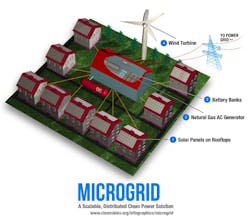Microgrid “Web” From Microgrid Developer ASI Energy
ASI Energy, a microgrid developer that created Energize Ithaca, a nodal microgrid that will help power a district energy system in downtown Ithaca, is backed in part by a $150 million investment fund.
How exactly was the company so successful in attracting investors for projects like its nodal microgrid project, which brings together solar and combined heat and power to create a district energy system?
A nodal microgrid operates with multiple buildings that have microturbines, each able to come online independently. They sell heat through a hot water loop built to serve a downtown area, according to the report, Community Microgrids: Smarter, Cleaner, Greener by Pace Energy and Climate Center.
In 2011, ASI Energy created a proprietary product called Energy Diligence. It’s “horsepower for investors,” says Herbert Dwyer, company president and CEO.
“It’s for doing due diligence,” he says. “It’s for investors. It’s not a feel-good software to make things look neat and pretty… It’s really more about horsepower for the investors. They want to see realistic numbers. Our investors are high level and smart and good with their money…If we’re going to scale microgrid in the US, it will be built around investment dollars.” The investment fund is also used for other projects, he notes.
Investors don’t understand the ins-and-outs of CHP, he notes.
“The problem we have in the CHP industry is that it’s a complex industry and has so many moving parts,” he says. “There are lots of hidden costs and structured fees.” It’s not always easy for investors to understand how the money will be generated, he says.
“Investors look at the output of our software when they’re deciding whether to back us up. When we look at systems with our software, we look at tax credits, incentives and other issues. It’s realistic economics…how efficiently can you take someone’s dollar and give it back to them due to the efficiency of the system.”
Matt Golden, director of the EDF’s Investor Confidence Project, says that this type of software is just what’s needed to get clean energy projects going.
“As clean and distributed energy and energy efficiency become a major part of our energy infrastructure, these approaches must stand up to the same level of rigor and due diligence applied to traditional large-scale project finance. Confidence in project cash flows based on actual data and risk analytics is critical to overcoming questions associated with any new asset class.”
Several leading companies have signed on to boost investor confidence in energy efficiency through the Investor Confidence Project.
The Energy Diligence software, says Dwyer, is the company’s “sweet spot.”
“We needed to do something to help us develop projects faster and move capital faster into our projects. The software is our sweet spot; we developed it in-house. We brought in the necessary resources to create the package and use it on a daily basis.”
The goal is to have the Ithaca microgrid up and running by 2018 with the aid of more than $20 million in private and public funding. Governor Andrew Cuomo’s office recently invited Dwyer to present Energize Ithaca’s plans to New York State Energy Research and Development Authority (NYSERDA) CEO John Rhodes and NY Prize Executive Director Micah Kotch. NY prize is a $40 million competition to help communities create microgrids.
Follow microgrid financing by subscribing to the Microgrid Knowledge Newsletter. It’s free.








